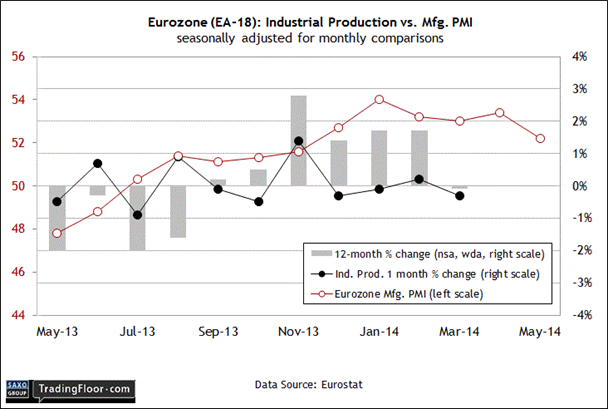• ECB does not rule out further stimulus measures
• Forecast calls for 0.6 percent jump in retail sales
• France weakest performer in May's PMI report
Fresh macro guidance for the Eurozone is on today's agenda, with the release of the European Central Bank’s monthly report on monetary matters and related subjects. Soon after, we’ll see the April update on industrial output for the Eurozone followed by May numbers on retail sales for the US.
ECB Monthly Report (08:00 GMT): The central bank’s monthly review promises to be an influential document after last week’s decision to take a more aggressive stance with monetary stimulus. Although the European Central Bank stopped short of rolling out a program of quantitative easing (asset purchases), ECB president Mario Draghi hinted that a European version of the US Federal Reserve’s QE strategy is a possibility.
It will be interesting to learn if the ECB mentions unconventional policy options in today’s bulletin. Another reference point to look for: the EUR. It’s clear that a weaker currency is part of the central bank’s goals, and the market seems inclined to play along so far. EUR/USD has been trending lower this week, leaving the euro 2.6 percent lower against its recent peak in early May relative to the greenback. But engineering a meaningful impact on the Eurozone economy by weakening the EUR requires a deeper decline – to 1.30 or even lower, according to an early June poll of currency strategists via Reuters. By that standard, the ECB's stimulus efforts have a long way to go when you consider that EUR/USD traded in the 1.355 range in yesterday's session.
Some economists forecast that the ECB will ultimately be forced to engage in asset purchases to keep disinflation/deflation risk in check. Draghi certainly left the door open for doing more. "We think this is a significant package but are we finished yet? No we are not," he said last week. "If need be, within our mandate, we aren't finished here."
The details about what comes next, and when, remain unclear. That’s why today’s monthly review from the ECB is sure to be read closely as the crowd searches for additional clarity.
Chart: Oanda for EUR/USD
Eurozone Industrial Production (09:00 GMT): Industrial activity in Europe is trending lower, in large part because of France. Although Europe’s second-largest economy posted a slightly better-than-expected monthly gain for April, the big picture for industrial production looks worrisome for the country. Indeed, the headline index fell 2 percent on a year-over-year basis in the start to this year’s second quarter. That's a sign that France will remain a heavyweight on the Eurozone’s prospects for recovery.
Despite the headwinds, analysts think we’ll see a 0.3 percent rise in April vs. the previous month. Modest growth is also the implied forecast in Markit’s Eurozone Manufacturing Purchasing Managers Index (PMI) for April. However, the progress may be temporary: the PMI data for May slipped to its slowest rate of growth in six months, largely due to a contraction in French manufacturing activity.
“France was the weakest performer overall [in the May PMI report], being the only nation to report a decline in new business and a near-stagnant rate of increase in production,” Markit advised in last week’s release.
Last month’s weakness won’t show up in today’s numbers for April, but the sliding PMI trend is a reminder that the outlook for the Eurozone is still shaky. Now-casting.com’s weekly estimates of quarter-over-quarter growth rates for the currency bloc’s second-quarter GDP fell to 0.21 percent in the June 6 update – roughly half as much as the nowcast from a month ago. Today’s report on industrial production may suggest that the outlook is brightening but the PMI and expected Q2 GDP numbers imply that there’s still rough terrain ahead.
US Retail Sales (12:30 GMT)
Today’s report will be closely read as the market looks for confirmation that the unexpected slowdown in retail spending in April was a temporary setback. Economists, in fact, are anticipating that we’ll see a rebound. The consensus forecast calls for a 0.6 percent jump in retail sales – a healthy improvement after April’s tepid 0.1 percent increase.
A broad review of economic indicators also suggests that retail activity will continue growing for the near term. The labour market in particular has been sending encouraging signals lately. The latest four-month gain in non-farm payrolls up to May is the highest for that rolling period in more than a year. This week’s update on job openings for April showed improvement too: 4.455 million new positions, a seven-year high. The gain beat expectations and represents a substantial rise over March’s level.
The improving momentum in the labour market provides a tailwind for consumer spending.
“Job openings are a measure of the demand for labor, so in general, you like to see a rising trend,” an economist at HSBC Securities told Bloomberg yesterday. “There’s been improvement in the labour turnover figures and business surveys also suggest that conditions are gradually improving.” That’s an encouraging clue for expecting that retail sales activity will improve as well. The calculus boils down to this: more workers with paychecks translates into higher spending. 
